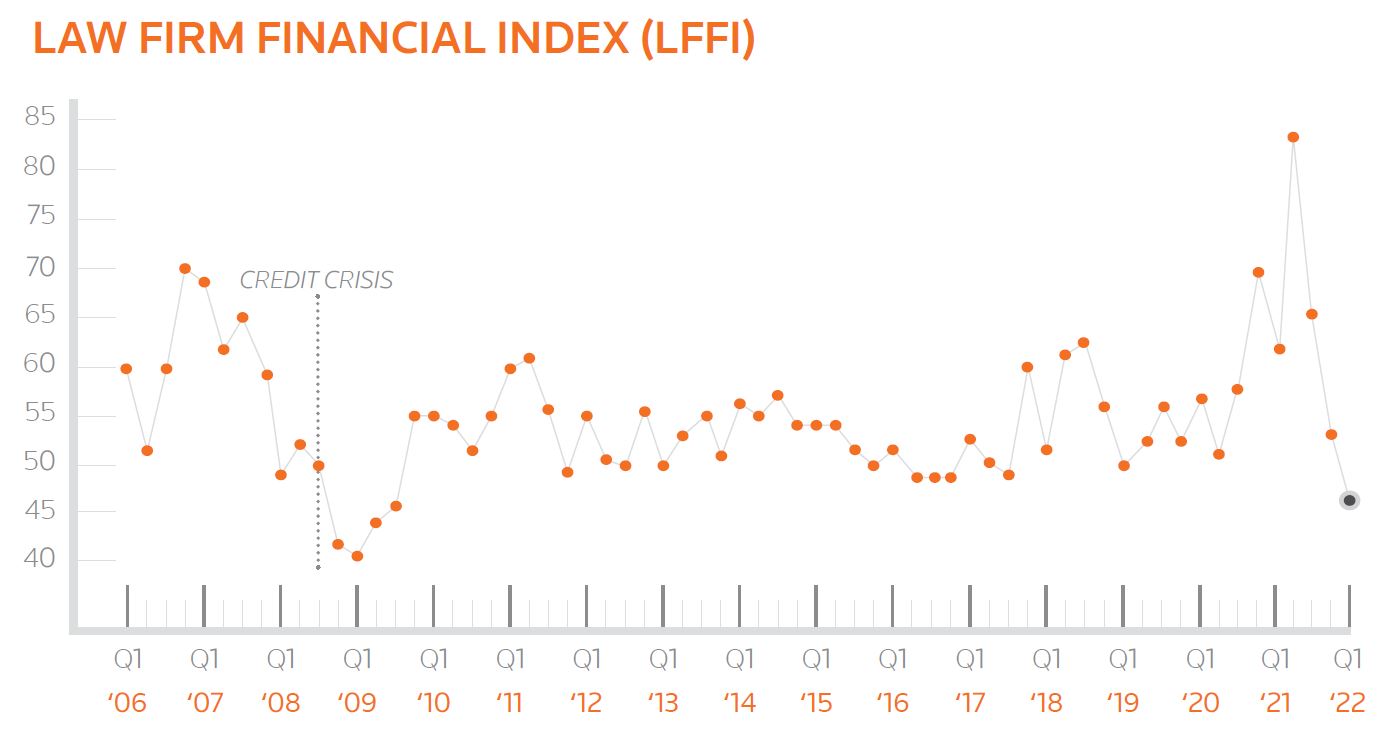Looking at the Law Firm Financial Index (LFFI) number for Q1 2022, you can’t fail to notice how rapidly the index declined even as many market fundamentals remain strong. While some decline was surely anticipated, however, the size of the drop-off may raise some eyebrows.
The first quarter’s results extend a three-consecutive-quarter slide in the LFFI, pushing the score down to 46, the lowest quarterly index figure since Q3 2009.
Key Takeaways:
-
-
Transactional Practices, especially corporate and M&A work, showed signs of slowing growth in Q1.
-
Direct expenses, or lawyer compensation, continued to accelerate in Q1, weighing down the index score most heavily.
-
Overhead expenses remain below pre-pandemic levels per lawyer, but continue to grow rapidly against a work-from-home environment.
-
The Law Firm Financial Index is a rebranded version of the Peer Monitor Index (PMI), which Thomson Reuters has published quarterly since 2006. While the fundamental methodology to determine the index score remains unchanged, the new name reflects an effort to incorporate additional insights to give the index score further context. Like the former PMI, the LFFI is a composite score, representing the quarter-over-quarter change in drivers of law firm profitability, which includes rates, demand, productivity, and expenses. Positive factors driving firm profitability will produce a higher score.
 In Q1 of this year, legal demand and rates were well in positive territory, while productivity stayed consistent with historical norms. However, like we saw in recent quarters, the impact of rapidly growing expenses, especially around hiring and retention, has overwhelmed any positives for the quarter, including this past quarter’s three-year high in Q1 demand growth.
In Q1 of this year, legal demand and rates were well in positive territory, while productivity stayed consistent with historical norms. However, like we saw in recent quarters, the impact of rapidly growing expenses, especially around hiring and retention, has overwhelmed any positives for the quarter, including this past quarter’s three-year high in Q1 demand growth.
This demand growth for law firm services remained strong, relying heavily on transactional practices, such as real estate, corporate (all), and labor & employment. Demand for mergers and acquisitions (M&A) work, however, dropped dramatically in Q1.
Without a doubt, this year already is bringing us some odd precedents, and it’s unlikely we’ve seen the last of these anomalies.
On the other side of law firms’ ledgers, direct expenses — compensation and benefits for all attorneys who are not equity partners — weighed the heaviest on the index score, clearly illustrating the ongoing impact of an increasingly expensive talent war that’s been ratcheting up for several quarters now. In Q1, we saw outsized bonuses paid out and the announcement of three new retroactive associate pay scales, both of which left many law firms struggling to keep up.
Other overhead expenses, such as support staff compensation, technology, and knowledge management & library service expenses all grew at comparatively more modest levels. Interestingly, despite other run-away expenses, law firms seemed to be increasing their technology spending, which was up 8% in Q1, and is currently growing at one of the fastest rates the market has seen since 2014.
Will 2022 be the “Year of Talent”?
In our previous report, we had dubbed 2022 the “year of talent”, and so far, this has carried some weight, although not every effect was anticipated. As a result, we have tinkered with how the LFFI reports and displays its data.
Without a doubt, this year already is bringing us some odd precedents, and it’s unlikely we’ve seen the last of these anomalies. And, unfortunately, if some of these downward trends continue, it’s likely that other critical law firm metrics — such as law firm profitability growth, for example — could mimic the LFFI’s downward plunge.







